Journal of Pollution Effects & Control
Open Access
ISSN: 2375-4397
ISSN: 2375-4397
Review Article - (2021)Volume 9, Issue 3
Plastics production (i.e. 450 million tons per annum globally), use and disposal (i.e. 300 million tons per annum globally) are one of the top environmental concerns and global waste management impediments. Over the past decades, researchers’ voices have repeatedly been raised for acting and saving inland as well as aquatic ecosystems being harmed by the increasing plastic pollution. Micro plastics have also been reported to be in tap water, bottled drinks and in fish we eat. Consequently, conventions have been signed, laws and regulations enforced (banning, increased taxation, etc.) in various regions and countries across the globe for lessening plastics harm on the environment. In this struggle, Rwanda looks to be in front line compared to other regional and continental countries; hence resulted in calling its capital Kigali by many, “the African cleanest city”.
In fact, more than a decade ago Rwanda has banned non- biodegradable plastic bags and this initiative was recently followed by the outlawing of single-use plastic items as one of long-term strategies of becoming a green and climateresilient nation. The ban aimed at minimizing dangers of plastic pollution to humans, farm animals, aquatic lives and the environment. Rwanda’s current strong institutional, political will, legal frameworks and active citizens in terms of eliminating plastic pollution foster socio-economic development and environmental protection; hence benefiting from ecosystem services. Active participation of citizens in community works (Umuganda in mother tongue; one of home-grown solutions of mutual collaboration to achieve specific goals), meticulous plastic related laws enforcement (strong political will) and public awareness campaigns (i.e. environmental clubs in schools, green education, etc.) are 3 pillars which are enabling Rwanda to the successful beating of plastic pollution. The national moto for sustainable environmental management is: “whatever cannot be recycled or reused must not be produced”.
Thus, the present paper reviews the state of environmental impacts of plastics, approaches adopted for alleviating the harm from plastics in Rwanda and their implementation procedures which gave credits to the country on global environmental protection scene so that lessons from these practices can be benchmarked or become the starting point to other countries with similar ambitions and goals. The current solid waste management (i.e mainly plastics) and challenges are also discussed in order to be addressed by the authority in charge. Data and literature were retrieved from peer-reviewed journal articles, websites, books, reports, and dissertations, local and international online newspapers.
Despite significant efforts made towards plastic pollution alleviation in Rwanda, to the best of our knowledge no scientific research has been so far conducted to prove how plastic wastes contributed over the past years to flooding, prevented crops from growing, to what extent plastic litters have restrained rainwater from penetrating various soil types and other forms of plastic pollution. Such studies are paramount for scientifically justify the ban initiatives in the country. This review resulted into encyclopedia that other researchers can build on, specifically to those wishing to learn from plastic banning procedures followed in Rwanda.
Rwanda, Plastic Waste, Plastic Ban, Kigali City, Polyethylene Bags, Non-Biodegradable Plastics, Environment in Rwanda, Plastic, Outlawing Plastic, Plastic Bags, Home Grown Solutions, Cleanest City in Africa, Break Free From Plastic
Globally waste production is on the rise. According to The World Bank, various urban areas of the world generated more than 2.01 billion tons in 2016 by; meaning 0.74 kilograms per person per day. The trends indicate that annual waste production will increase by 70% from 2016 levels to 3.4 billion tons in 2050 as a result of rising population growth associated with urbanization [1].
Waste disposal and management remain a hindrance for many developing countries and cities [2]. More than 90% of their waste is usually burnt or dumped in inappropriate sites hence resulting into severe health and environmental consequences. Such poorly managed waste dumping sites contribute to gradual global warming through methane, carbon dioxide and nitrous oxide emissions among other pollutants [1].
Since 1950s, the volume of produced plastic products has surpassed those of almost any other materials. This is associated with plastic properties such as their cheap price, lightweight, corrosion resistant, accessibility and availability plastics products have dominated the global markets over the past decades; hence posing many problems to their management once discarded as wastes [3,4]. Since 1950s, reports indicate that only 9% of all plastics ever manufactured have been recycled. The remaining portion has either end up in landfills, discarded in the environment or burnt, hence leaving toxic emissions in the environment [5]. According to a study conducted by the English Environment Agency 60% of the plastic bags environmental impacts happen before we even put our groceries in them.
In this review paper, with reference to peer-reviewed journal articles, websites, books, reports, dissertations, local and international online newspapers (The New Times Publications SARL, Aljazeera, The New York Times, etc) we discuss the current state of knowledge in environmental impacts of plastic trashes on crop health, agricultural soils, waterways (drainage systems and water bodies), wetland ecosystems, human health and oceans. Additionally, we present an overview of waste management (plastic wastes in particular) in Rwanda, better practices adopted to reduce plastic pollution, challenges and suggesting next research direction for sustainable environmental management and towards green economy.
Plastic production and consumption are all on a rise in today’s world, therefore posing disposal challenges specifically in developing countries [2]. The United National Environment Program (UNEP) indicated that nearly 450 million tons of plastic items are annually produced worldwide (with China leading in production by referring to Figure 3), with 40% of production categorized as single use packaging material discarded upon single use. It is therefore projected by 2050 that plastics weight will be exceeding that of fishes in global ’oceans as long as the current plastics production, use and disposal are maintained [6].
Globally most plastics items are synthetized from crude oil (Figure 1), natural gas or coal (fossil fuels); a proof of their significant contribution to global warming [7,8]. Most of the produced plastics end the journey in one of the following ways: recycled, incinerated, landfilled, dumped or littered in the environment. Figures on plastics which have been disposed since their generation up to 2015, indicate that 9% have been recycled, 12% incinerated and 79% of remaining plastic trashes have been accumulated in landfill and dumps or littered in the environment [9].
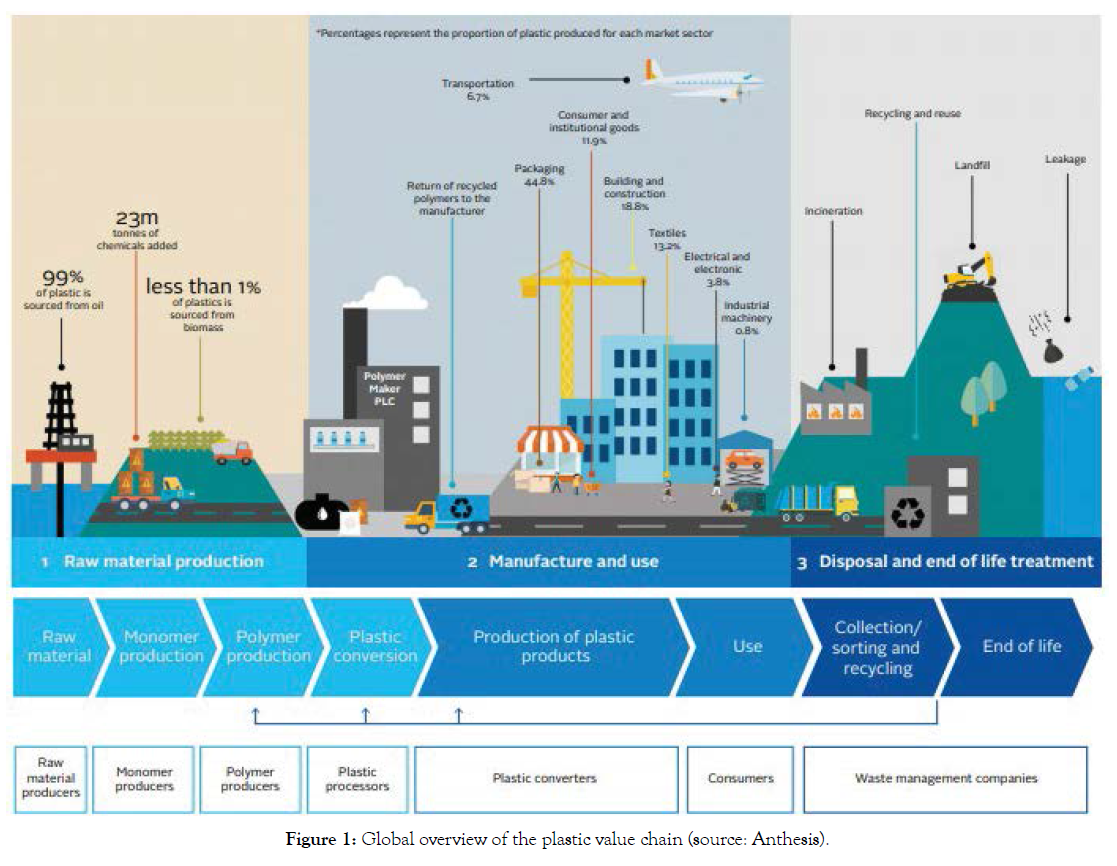
Figure 1. Global overview of the plastic value chain (source: Anthesis).
Plastic wastes have various impacts on the environment such as harming wetlands sustainability (water quality, soils, vegetation, altering water velocities, flow path, etc.). Plastic associated pollution affects wildlife, wildlife habitat, humans, lands, waterways and oceans [10].
Various surveys and experiments indicated that plastic bags and containers made in polystyrene foam can take thousands of years to decompose, polluting soil and water. Generally, cigarette butts, plastic drinking bottles, bottle caps, food wrappers, plastic grocery bags, plastic lids, straws and stirrers, other various kind of plastic bags, and foam take away containers are the most common single use plastic items (Figures 2-4) found in the environment [9].
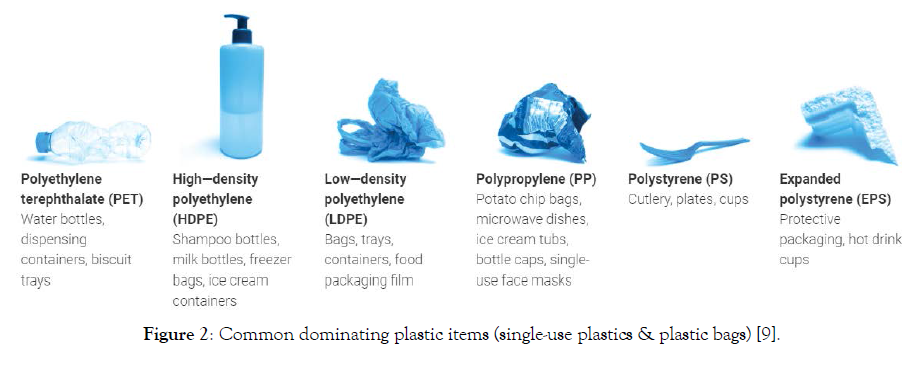
Figure 2. Common dominating plastic items (single-use plastics & plastic bags) [9].
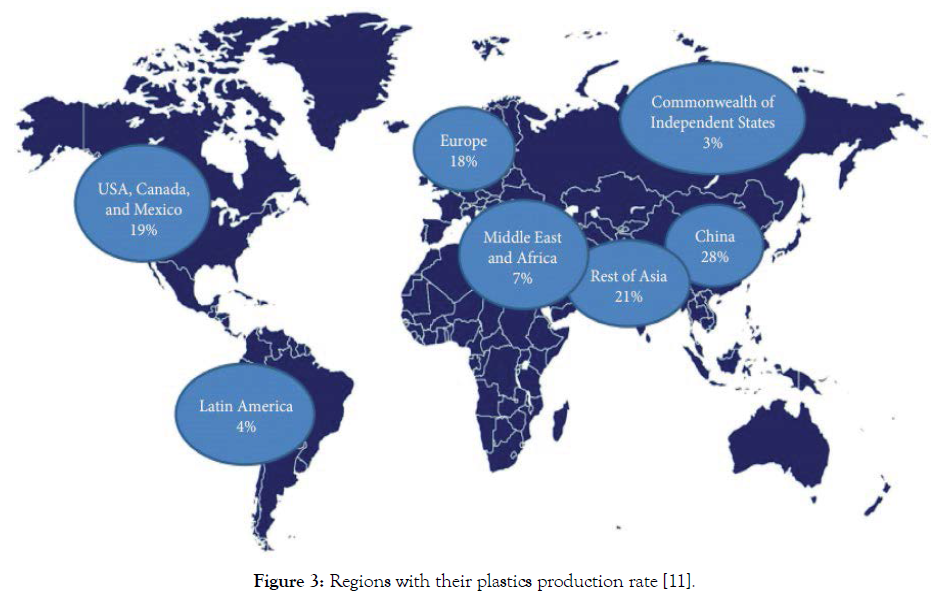
Figure 3. Regions with their plastics production rate [11].
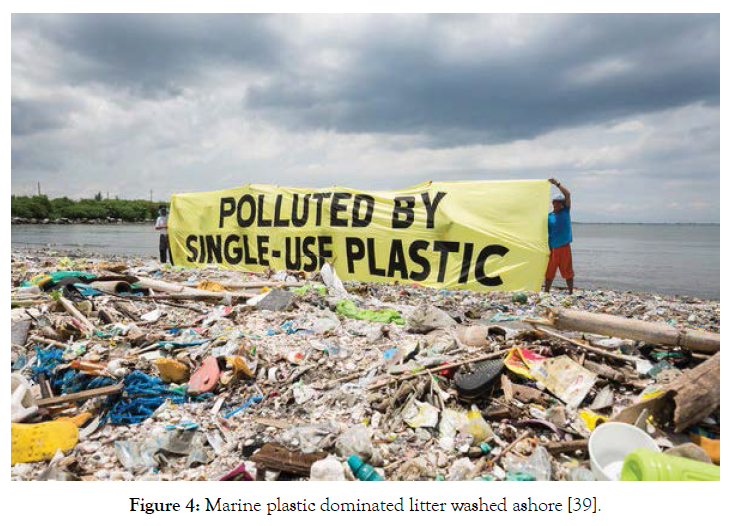
Figure 4. Marine plastic dominated litter washed ashore [39].
Plastic Debris Impacts Crop Health and Agricultural Soils in Long Term
Few decades ago, up to present the researchers community has been discussing impacts of using plastics as mulches in global crop production. Over the past years the application of these kind of mulches has positively on one hand improved the crop yield, increased soil temperatures, weeds control, nutrients loss and soil moisture content (improved water use efficiency) especially in areas with low temperatures [11,12]. In the meta-analysis study conducted in 721 cropland sites across China a team of researchers found that crops grown in soil with large volumes of plastic debris (i.e. plastic mulches) displayed a reduction in yield, height and root weight. These plastic trashes were also reported to have caused alteration of soil chemistry and structure, reduction in phosphorus, soil organic matter content [12] and soil microbial community composition; hence affecting the organic matter dynamics [13,14].
In close agreement with the above findings, Qi et al., [15] in their experimental study on the impacts of plastic debris (5mm low-density macro polyethylene mulches and < 1mm low-density micro polyethylene mulches) on sandy soil, revealed a significant change on bulk density, field capacity, porosity, saturated hydraulic conductivity and soil water repellency. In this study the type, size and plastic trashes contained in cropland as well as their interaction played complex roles in the variation of measured soil parameters.
The study conducted by Jiang et al., [16] with the aim of investigating the potential effects of Residual plastic film fragments (RPFF) on soil physical properties, water infiltration and distribution in the soil, found a significant influence of RPFF on soil physical properties, modification of soil water distribution and decreased the matching degree of the flow distribution in root zone of maize crop. The findings from this study highlighted the significance of clearing mulch plastic residues for agricultural water management. On the other side the presence of plastic debris significantly increased the rate of soil evaporation due to the created channels for water movement by these plastics. The same experiment revealed that evaporation was higher in soils treated with 2 mm plastics compared to soils treated with 5 and 10 mm plastics, and increased with increasing of soil plastics content [17].
Furthermore, the study conducted by Sintim et al., [18] for assessing the impacts of biodegradable plastic mulches on soil health revealed no significant impacts of such mulches on soil properties in short time. However this study and others which worked on biodegradable plastic mulches recommended further surveys and experiments to prove that the same hypothesis can be applied to long term periods [18,19].
Plastic Trash Harm Waterways and Wetlands Ecosystems
Discarded plastic trashes from our throwaway society are responsible of choking several waterways such as natural rivers, storm drains and culverts mainly in developing countries with inadequate waste management systems. In fact when it rains, significant number of plastic litters are transported by storm water and deposited to rivers, wetlands, drainage systems and other water bodies [6,20]. Once these waterways are blocked, floods and bank erosion can occur leaving several damages. For example, in 1988, plastic bag litter in Bangladesh clogged drainage systems resulting into devastating floods which caused numerous deaths and two-thirds of the country was submerged [9]. Plastics have been reported by several studies to affect wetlands ecosystems such as water quality (chemistry), alter water velocities, flow paths, soils and vegetation [21,22]. Around the world, micro plastics have been found in various water resources (i.e. streams, rivers, lakes and oceans). A significant portion of these micro plastics ends up in our drinking water and the fish we usually eat [23-25].
Furthermore, many rivers of the developing world play a major role in acting as transport route of plastics debris from land to the world’s oceans. This debris does not only harm marine aquatic species but also riverine ecosystems (fishes, etc.) [26,27].
Plastic Trash Affects ocean’s Fauna and Human Health
Every year, more than 8 million tons of plastics ends up in the world’s oceans [28,29]. Products made from Styrofoam (a common raw material) such as plates, food and drinks packaging (coffee cups, egg cartons, etc.) contain toxic chemicals such as styrene and benzene. Both chemicals have the potential to cause cancer and can lead to adverse impacts on our nervous systems, respiratory system, reproductive system and possibly affecting kidneys and liver [9,30]. There are other evidences showing that once drinks or food contained in Styrofoam containers are heated significant amount of toxins can be transferred to food and drinks. In developing countries plastic wastes are burnt for making fire or heating; releasing large quantities of toxic emissions which are harmful to human health [2,31].
The study conducted by Markowicz & Szymańska-Pulikowska, [32] in analyzing the possibility of environmental pollution by composted biodegradable and oxo-biodegradable plastics, revealed that micro plastics from composts can easily be displaced in the environment, penetrate into living organisms (animal and humans), hence posing various threat.
Furthermore, when plastics block waterways, created standing waters become breeding ground for diseases such as malaria that are transmitted by bugs or parasites. Most malaria cases and deaths occur in sub-Saharan Africa [33-35].
When it comes marine ecosystem, a lot has been documented to better understand how plastics originating from land end up in world’s oceans via river systems [36], international and regional conventions have been signed (i.e. Barcelona Convention for preventing the pollution of the Mediterranean Sea, OSPAR Convention for protecting the marine environment of the North-East Atlantic Ocean around Europe, etc.); however their enforcement is still challenging many [37].
Various species including invertebrates, turtles, fish, seabirds, mammals among others have been reported by many studies to be among victims of increased plastic pollution. In short, these species ingest plastic mistakenly confusing it with food, or become entangled in plastic trashes; therefore this result in impaired movement, feeding, reduced reproductivity, lacerations, ulcers, and death [4,38].
Plastics on African Continent
Currently more than 500,000 km2 of land on the African continent faces degradation resulting from soil erosion, pollution, salinization and desertification [39-41]. Wetlands which occupy 1% of the total continent territory are the most harmed and polluted ecosystems caused by overexploitation for firewood, timber, conversion to agriculture and other uses; pollution from plastics, oil and gas exploration; increased sedimentation; and changing hydrology [42,43].
Plastic trashes and related pollution are mainly impacting developing countries in Africa. This situation is exacerbated by lack of appropriate waste collection and recycling facilities [44]. As a result, during periods of rains discarded plastic debris are transported by storm water and end up in waterways, rivers and drainage systems. For example recently Ghana faced damages counted in millions of dollars where plastic wastes clogged drainage systems resulting into devastating floods which killed 150 people and led to fuel fire [45]. In 2010 South Africa alone was reported to use nearly 8 billion plastic bags per year. 96% of them end up in landfill taking 1000 years to decay [46].
Recent surveys in Mauritania indicated that around 70% of livestock (cattle and sheep) in Nouakchott are killed by eating plastic bags. Furthermore, a significant portion of plastics to carry food on the continent end up in stomach of marine animals. When fishes consume micro plastics with toxins, they may not directly die and later these harmful substances end up on our plates hence impacting human lives [47].
Following the global joined efforts for reducing plastics pollution, currently out of 54 states on the African continent nearly 34 nations have imposed restrictions on single-use plastic bags (Figure 5). Some have started implementing laws banning such plastics and others have the law in place but implementation is another issue [44]. Some countries have enforced these laws due to the limited financial resources of managing or recycling plastic wastes. Compared to other regions of the worlds it seems that Africa is doing well for the sustainability of its environment [48,49]. However, harmonized legal integration of regional and transboundary efforts are lacking in Africa for regulating the ban of single-use plastics and plastic bags [50]. The lack of this coordinated framework provides room to producers, users and smugglers of such banned products. This is common to other regions of the worlds such as countries of the Pacific Alliance (Mexico, Colombia, Chile, Peru, and Ecuador) where the legal component among state members is still hindering the plastics governance in the region. The existing regulations to control the consumption of plastic bags and single use plastics are still extensive and scattered [51].
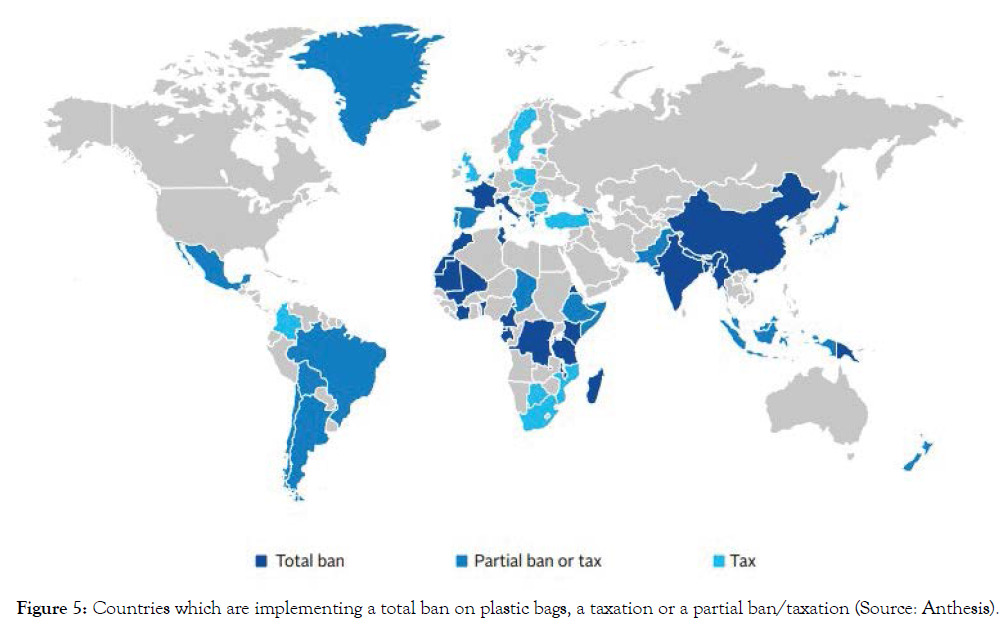
Figure 5. Countries which are implementing a total ban on plastic bags, a taxation or a partial ban/taxation (Source: Anthesis).
In addition to the above, poorly enforced plastic bag legislation, resisting or inadequate communication, consultation and involvement of private sector in the development of such regulations, and limited effective alternatives are major factors obstructing effective plastic bag waste management in Africa [11].
Plastic pollution alleviation is a global environmental concern which cannot be addressed by single action, but the lasting solution seems likely to be the following three combined approaches in regards with local considerations: banning single-use plastics; changing plastic items originating from fossil fuel to other alternatives such as paper, glass or biodegradable plastics; and waste collection systems improvement for ensuring the adequate collection and reprocessing or safe disposition of waste [52].
Plastic Waste Management in Rwanda
Being cheap in cost, light weight among other properties, the use of plastic items has evolved globally replacing others in metals, wood, glass, etc. [3]. However, over the years numerous research works have warned the impacts of plastics waste on environmental, human and animal lives. Unless convenient measures are taken for ceasing plastic pollution; projections indicate that oceans’ plastics will outweigh fishes by 2050. For the aforementioned reasons, various governments have initiated tough regulations, innovations launched in various businesses and individuals started acting towards plastic pollution reduction [9].
In early 2000s plastics dominant litter and garbage was more common in Rwanda. Rubbish piles were in many roadsides of the country and drainage ditches were clogged by plastic bags resulting into stagnant water; the favorable mosquito breeding grounds [53]. Plastic waste was also a danger to the soil, agriculture and cattle [54]. Recent surveys showed that in average 300-450 tons per day, nearly 165,000 tons per year of solid waste from Kigali city are dumped in Nduba landfill, the main landfill of the city located in Gasabo district. The population growth trends and economic development indicate that in 2030 approximately 1300 tons per day will be generated in the city of Kigali [55]. Nduba dumping site (Figure 6) is still a major challenge to environment sustainability due to luck of appropriate waste manipulation (separation, recycle, etc.) technology resulting into release of Greenhouse gas (GHG) (i.e. such as CH4, N2O, CO2, etc.) which contribute to global warming and air pollution [56,57]. Therefore, further studies are needed to be understood how toxic chemicals (i.e. leachate), vermin and other spontaneous combustions [55] from this dumping site could affect the groundwater, waterways, poisoning ecosystems and harming wildlife of the neighborhood [58]. Nevertheless, the data on waste management (daily weight of generated waste, composition, etc.) is still lacking or incomplete and out of date in different cities districts of the country as reported by Kabera et al., [59] among others.
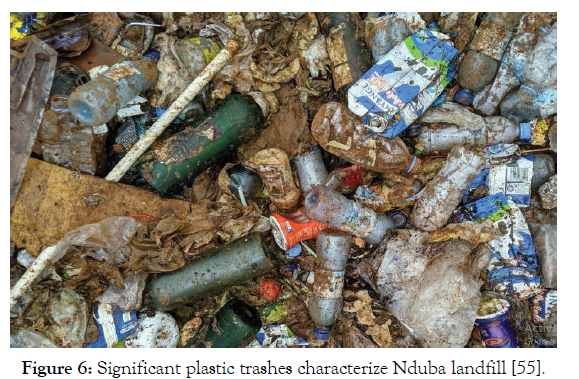
Figure 6. Significant plastic trashes characterize Nduba landfill [55].
Plastic ban in Rwanda
With the aim of becoming a developed, climate resilient and low carbon economy by 2050 [60], since 2008 Rwanda has banned the manufacture, importation and the use of plastic bags also known as polyethylene bags or non-biodegradable polythene bags (NBPB) [44] with few exceptions (hospital plastic aprons, plastic bags used in tree nurseries, plastic reservoirs, cellophane for food wrapping in hotels, etc.). Currently, biodegradable bags are still used mainly for frozen fish and meat. In addition to that, plastic packages for foods (e.g. potato chips, etc.) are only allowed for approved companies with clear business plan detailing how their bags will be collected and recycled [61].
This initiative was taken for protecting the environment from plastics harm such as air pollution when plastics are burnt, improving soil physics (i.e. structure, etc.), hydraulics (i.e. infiltration rate, moisture holding capacity, etc.) and chemical properties (i.e. nutrients contents, etc.). Outlawing plastics was not only a strategy of finding long lasting solution to plastics recycling cost but also was in line of cleaning the city of Kigali in particular, and the whole nation in general; in 2008 this resulted in calling Kigali the cleanest city in Africa by UN Habitat [9,62].
This practice gave credits to Rwanda regionally, continentally and globally for environmental protection and green economy.
Single use plastics such as disposable dishes, plastic bottles, straws, coffee stirrers, disposable cutleries, etc. The ban of single use plastics was legalized in 2019 with the aim of stopping the manufacture, imports and use of single-use plastic items [63]. This initiative is in line with international efforts of minimizing the environmental pollution from plastic wastes [64]. Other strategies used for the continuous reduction of plastic pollution include: National Environment Week which included community works, beat plastic pollution walks, plastic recycling exhibitions and national inspection of the illegal use of plastic bags [6] and organizing national competitions for passing environmental protection messages to the public through poems, songs and drawing among others [65].
The law N° 17/2019 of 10/08/2019 outlawing the manufacturing, importation, use and sale of plastic carry bags and single-use plastic items also imposed sanctions which include confiscation of such items, paying administrative fine of around 10500 USD to the person manufacturing such items. For a person who imports prohibited plastic items, fines can go up to ten times their cost. Fines for wholesaling and retailing these outlawed plastic items are nearly 750 USD and 310 USD respectively. Piling or disposing such prohibited plastic items on private or unauthorized public place is fined to nearly 50 USD. This law also imposes between 52 USD and 5,220 USD for those who deliberately dump plastics in public space and firms which don’t implement adequate waste management respectively. In addition to this fine the convicted is ordered to remove those trashes and make repair of damages caused on his/her own expenses [63]. The national police play a significant role in law enforcement, examples are in Figure 7.
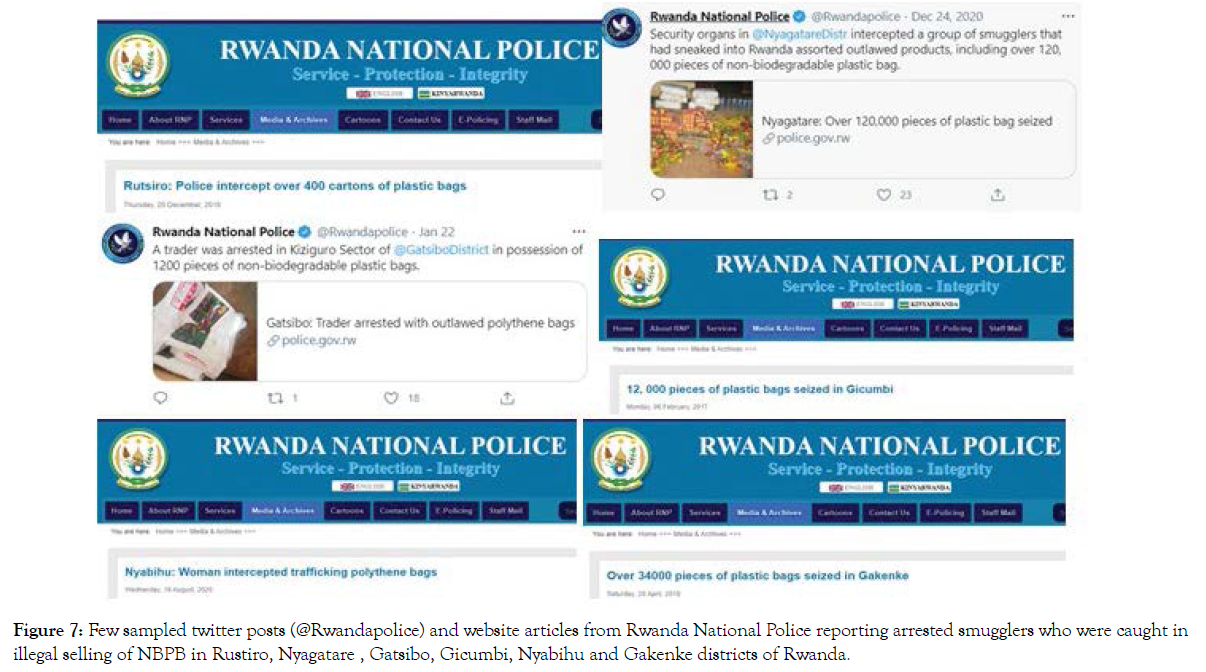
Figure 7. Few sampled twitter posts (@Rwandapolice) and website articles from Rwanda National Police reporting arrested smugglers who were caught in illegal selling of NBPB in Rustiro, Nyagatare , Gatsibo, Gicumbi, Nyabihu and Gakenke districts of Rwanda.
Since the 2008 plastic bags ban, the country has seen tremendous reduction in animal deaths, crop production, increased flooding and malaria [61,66] but this needs the country specific scientific evidence studies for justifying the reality behind the ban. Economically, the plastic ban is believed to be a smart move due its impact in promoting ecotourism and increase in job creation in Rwanda. In 2014, around 1.2 million tourists visited the country; showing an increase of 4% compared to the previous year. In addition to these advantages, plastic outlawing played an undoubtable role in reduction of plastic waste, therefore saving government funds that would have been used to pay employees for cleaning up such trashes [45].
Despite the positive impacts of such laws, policies and regulations aiming at environment protection (Figure 8), on the other hand the ban of plastics resulted into price hike of packing and production locally hence affecting some manufacturers, traders, exporters, importers and reduction of competitiveness at national and regional levels. In arguing with the above, analytical study conducted by Herberz et al., [3] concluded that single-use items are harmful to the environment disregarding of their material (plastic or no plastic). The study also revealed that the general ban of singleuse items is the mostly effective way of reducing consumption and thereby pollution. Globally more than 127 countries have put in place laws for regulating the use of plastic bags (Figure 5) and single use plastics (UN Environment, 2018). In support of collective efforts, in 2017 the United Nations launched the ‘Clean Seas’campaign to eliminate single-use plastics by 2022.
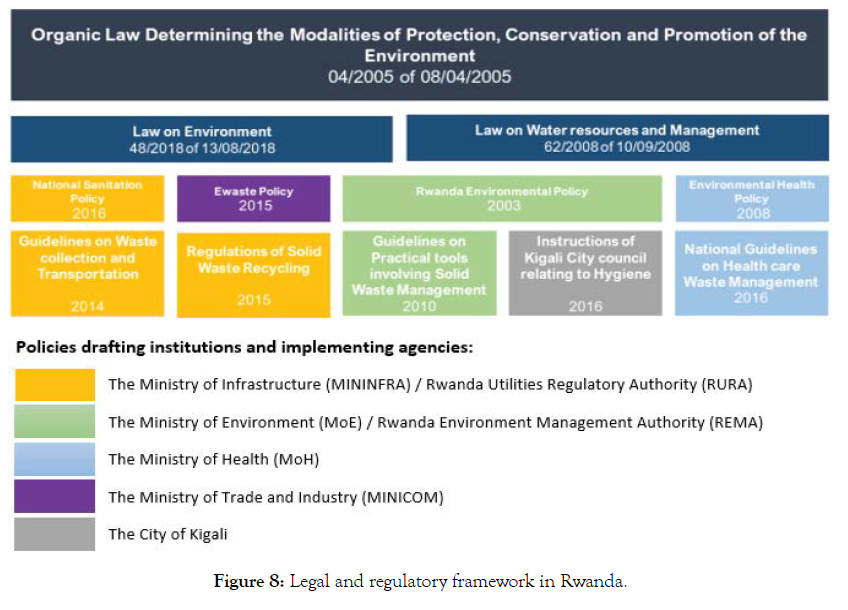
Figure 8. Legal and regulatory framework in Rwanda.
Opportunities from Plastics Outlawing in Rwanda
According to the World Economic Forum, globally, nearly plastic trash equivalent to 300 million tons is produced annually and 90% is not recycled. In 2015, the annual global plastic production by industrial sector was estimated at more than 400 million with which plastic packaging was the largest production; nearly 40% of items used just once and then discarded [9].
Waste management in developing countries particularly in Sub- Saharan region is a major sustainable issue [57]. Prohibiting the use of NBPB and single use plastic items in Rwanda has contributed not only to cleanliness but also to promotion of investment and development opportunities in sustainable packaging alternatives, recycling (plastic waste, domestic waste, electronic waste, etc.) and creating hundreds of new jobs [56,67]. These practices are expected to also lower the burden on the country’s waste management system [6].
In the first phase of NBPB ban, the decision resulted into black market of plastic bags which made those caught to be jailed or pay an adumbrative fine. Over time, the plastic bags were replaced by paper bags, made in cotton bags and other made in Rwanda handcrafted bags [68,69]. Some companies in the country turned plastic litter into business, examples are:
COPED (Company for Environment protection and Development); a professional waste management and transport company has recently initiated projects of turning plastic wastes (as binding material) into affordable construction materials such as plastic bonded sand blocks (pavers or bricks), tiles, etc. Recent studies and experiments conducted in finding solution to increasing polyethylene plastic bags (sachets) indicated that when melted and mixed with sand, the mortar obtained can be transformed into strong plastic bonded sand blocks with 27MPa. Such blocks can be used in a range of applications including pavement and it is presented as a sustainable solution to plastic waste management specifically in developing countries where recycling of plastics remain a challenge to public health and environmental safety [70-72].
This sanitation company (i.e. COPED) mainly based in Kigali city plans also to make new plastic bottles, fibers and cloth threads by recycling used ones in accordance with approved standards. The collected plastics trashes are from households, industries, healthcare centers, commercial buildings and construction sites [73,74]. In line with international air pollution control commitments in countries 2030 emission-reduction plans under the Paris Agreement, Rwanda pledged to lower its pollution levels by 16% (i.e. nearly 4.6 million tons of CO2) by 2030 [75]. Waste management practices are expected to significantly contribute to climate change impacts mitigation.
Another example is ECOPLASTIC; a company which was initiated in 2008 with the aim of manufacturing other plastic items from recycled plastic waste. On average this plant produces 50 tons of tree nurseries covers and 100 tons of other materials such as dustbin bags for waste collection, medical impermeable bags, improved crop storage, greenhouse tents for horticulture and sheeting used in roofs construction to name a few [47,76].
To ensure the success of national green development agenda the government invested in e-waste handling projects. The most recent example is the 2014 initiated e-waste dismantling and recycling facility located in Bugesera district which has an annual capacity of processing over 7,000 tons of electronic and solid waste. This plant mainly dismantles and refurbishes electrical and electronic waste; hence the materials produced are distributed at a low cost (i.e less than 1$ per kilogram of materials) to local and regional partnering recycling firms and industries. Products such as phones, printers, reusable computers are part of e-waste handling from this plant. To ease the waste collection, the plant has set up various collection points across all 30 districts of the country [60,77].
Nearly 2% of all produced plastic and biodegradable solid wastes are recycled by small scale operators who turn them into cheap cooking briquettes and manure for improving cropland fertility. Other ecofriendly entrepreneurs (cooperatives, etc.) make bags from vegetable wastes. Presently more than 100 companies are employed in cleaning activities and other 23 in solid waste management across the country [56].
Despite the progress and efforts invested in waste management and recycling many firms involved in the business claim limited capacity in expanding landfills and insufficiency of waste sorting systems at the source for making treatment affordable and easier.
Furthermore, despite efforts being put in fighting plastic pollution, environmentalists and various plastic industries worldwide are arguing on the carbon footprint of other alternatives (cloth, etc.) proposed to replace plastic bags. Plastic industries believe that most of these new alternatives (their manufacturing processes) emit higher Greenhouse gases (GHG) in comparison with plastic bags reusing and recycling emissions [61].
Community Works (Umuganda) as Lasting Solution to Plastic Wastes Recovery
Community works also dubbed Umuganda simply means ‘coming together in common purpose to achieve an outcome’ [78,79]. These practices which date back into Rwandans culture of mutual cooperation and self-help to achieve a common goal has resulted into numerous socio economic and environment protection benefits (Figures 9-12) by using the working population of the country [80]. These community works have been legalized (Organic Law Number 53/2007) and take place on every last Saturday of each month (from 8:00 A.M to 11:00 A.M); therefore, failing to attend them result paying fines (the 2007 law that governs community works proposed Rwf 5,000 nearly 6USD as the maximum fine for dodging or not participating in such works [53,81].
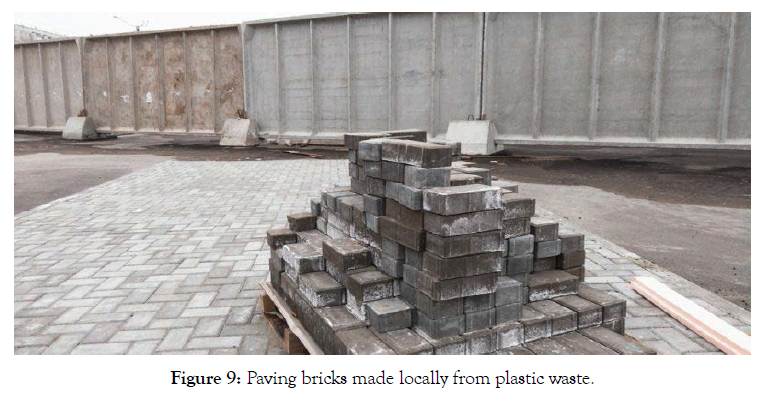
Figure 9. Paving bricks made locally from plastic waste.

Figure 10. Economic benefits brought by Umuganda [78].
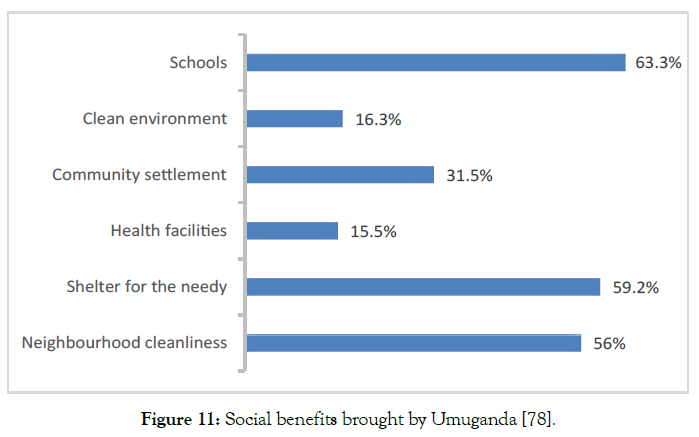
Figure 11. Social benefits brought by Umuganda [78].
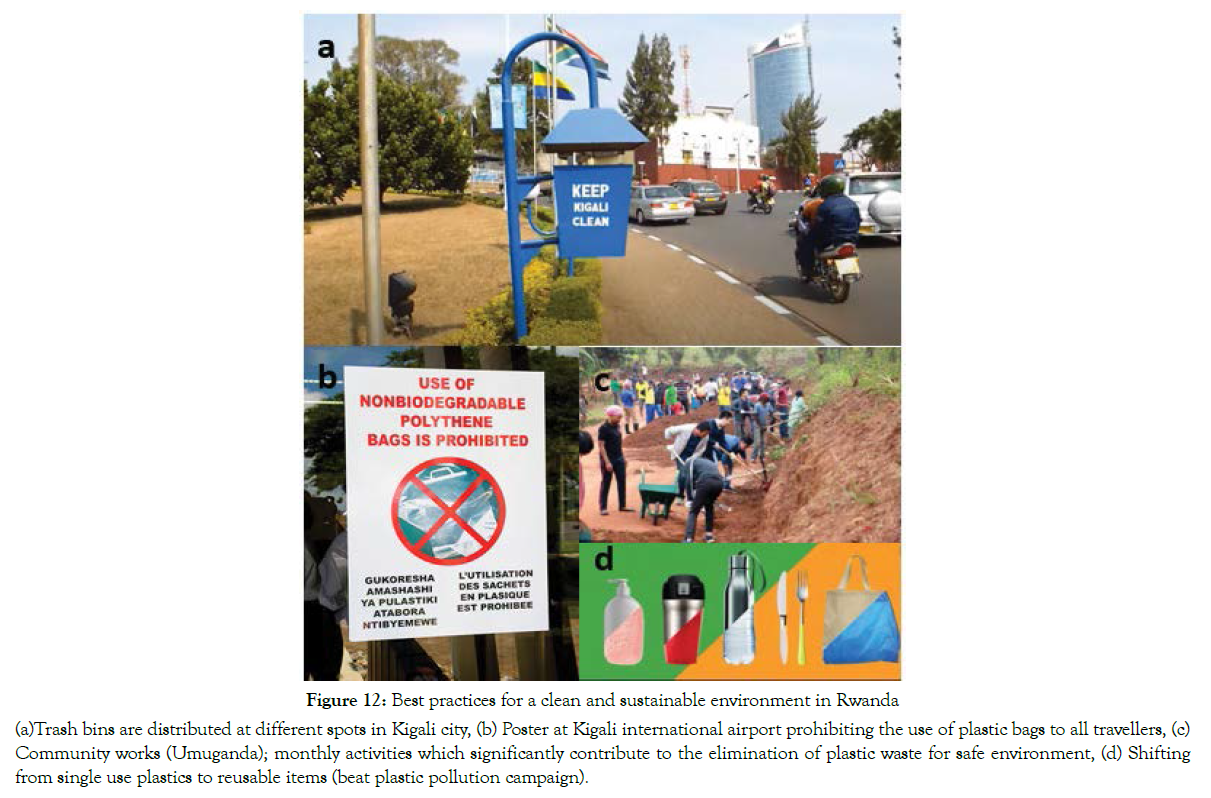
Figure 12. Best practices for a clean and sustainable environment in Rwanda
(a)Trash bins are distributed at different spots in Kigali city, (b) Poster at Kigali international airport prohibiting the use of plastic bags to all travellers, (c) Community works (Umuganda); monthly activities which significantly contribute to the elimination of plastic waste for safe environment, (d) Shifting from single use plastics to reusable items (beat plastic pollution campaign).
Referring to the 2015-2016 fiscal year report from the ministry of local government (MINALOC) the participation of citizens eligible in these mandatory works (age between 18-65) was at 91.3% across the country. The participants of these activities are not paid and they are conducted under the supervision of selected committees which in turn organize, guide, evaluate and report all activities of the day.
Most of community works in Rwanda are linked with environmental protection [79]. To name a few cleaning neighborhoods (collecting plastics wastes, sweeping, etc.), maintenance of drainage systems for flood control, bush trimming for destroying hiding place of mosquitoes, infrastructures construction, constructing shelters for vulnerable people, soil erosion control (trees planting, radical terracing), wetlands rehabilitation are part of conducted public works. This is part of Rwanda’s home-grown solution which indicates the willingness of population to build the country towards the sustainable environment [78,80,81].
Apart from environmental restoration and cleaning activities, Umuganda is also a channel which is used by local leaders to inform citizens (news, etc.) and provide announcements. Through various discussions, problems and corresponding solutions are shared together to achieve a common understanding [81].
Several efforts such as rules and laws development and enforcement (fines, seizing traffickers and smugglers of banned plastic items, etc) have been put in place for eradicating plastics bags; hence the resulting consequence is its remarkable cleanliness on the continent. Over the years the monthly community service (known as umuganda) has played a significant role in curbing plastic pollution across the country.
The same long process needs time to significantly eradicate single use plastics; a process which was recently initiated with the aim of protecting the environment and alleviation of plastic pollution. However apart from cleaning the country’s city in particular and a long-lasting way of finding solution to heavy recycling costs of plastic wastes; a lot has to be done in terms of researches in estimating and conducting impacts assessment of plastic debris left in croplands to better understanding how plastics (visible & micro plastics) affect terrestrial ecosystems such as croplands soils, crop production, hydrological processes (i.e. infiltration, soil evaporation, etc.), water resources (i.e. quality, quantity, etc.) and measurable long term benefits of NBPB banning and elimination of single use plastic items. Findings from such studies could improve existing knowledge on plastics hence ensure sustainable environment at local, regional, continental and global scales.
Furthermore, breaking free from plastics and addressing their pollution should not be taken at national scale only. It involves collaboration between several stakeholders such as neighboring countries, NGOs and increased public awareness campaigns to make the laws known. In addition, more efforts from public private partnership are paramount to improve waste collection and construction of sanitary landfills.
On the other hand, the 'polluter pays' principle as an internationally accepted measure of bearing the pollution costs needs to be elaborated more by including all aspects of plastic pollutions which may occur (plastic burning, throwing/discharging plastics in water bodies, etc.). It is time that major plastic polluters take full responsibility and adopt real solutions for plastic pollution crisis. The current laws in Rwanda mainly deal with sanctioning manufacturers, importers, sellers and users of banned plastics.
In addition, the adoption of reuse, recycling and reduce (the three R's) concept which is globally recognized for waste elimination, energy saving and environmental protection, needs to be integrated in all waste management chain for sustainability. Just know that “reduce” and “reuse” come before “recycle”. Plastic industries should remember that making new plastics is fueling the climate crisis. Waste-to-energy technologies (recovery of energy from waste) can play a vital role in waste management. The aforementioned technics produce briquettes and pellets used for cooking food hence reducing the number of trees being cut for the same purpose.
Besides contributing to a better general understanding of plastic debris impacts on terrestrial and aquatic ecosystems and lessons on how Rwanda has performed to significantly reduce plastic pollution, we hope that this paper also provides directions for future research. If the political will really exists and true efforts are made; reduction in plastics pollution will be achieved.
Citation: Hakuzimana J, Break Free From Plastics: Environmental Perspectives and Lessons from Rwanda. J Pollut Eff Cont 9:276. doi: 10.35248/2375-4397.20.9.276
Received: 17-Feb-2021 Accepted: 25-Mar-2021 Published: 01-Apr-2021 , DOI: 10.35248/2375-4397.20.9.276
Copyright: © 2021 Hakuzimana J. This is an open access article distributed under the terms of the Creative Commons Attribution License, which permits unrestricted use, distribution and reproduction in any medium, provided the original work is properly cited.